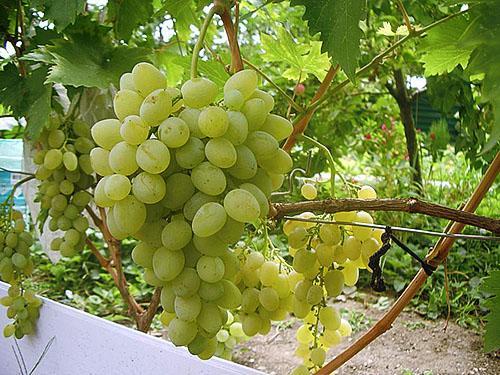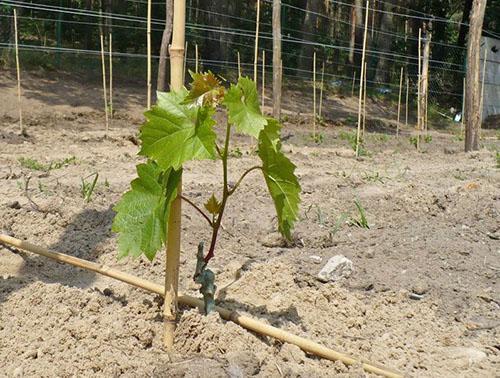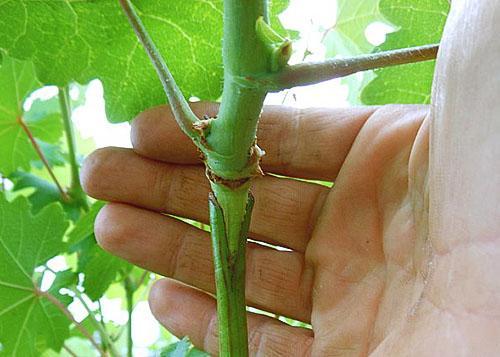Grafting a new grape variety onto an old bush
 Cuttings of varietal grapes can be grafted onto an old ordinary bush. Thus, they achieve several results at once: they improve the taste of the berry, get a harvest in the shortest possible time, and increase the resistance of the varietal plant to diseases. The uniqueness of the procedure is also in the fact that several different varieties can be grafted onto one old bush. Grafting grapes is fun and rewarding. There are several ways to carry out this procedure.
Cuttings of varietal grapes can be grafted onto an old ordinary bush. Thus, they achieve several results at once: they improve the taste of the berry, get a harvest in the shortest possible time, and increase the resistance of the varietal plant to diseases. The uniqueness of the procedure is also in the fact that several different varieties can be grafted onto one old bush. Grafting grapes is fun and rewarding. There are several ways to carry out this procedure.
Spring grafting

Although this method is quite popular and simple, it still requires preliminary preparation:
- It is imperative to comply with the seasonal condition - the end of May is best suited. It is at this time that the growth of the vine accelerates, and the juices move actively.
- The bush that will be the stock is pruned during dormancy (early spring or autumn). The cut is made 5 cm below the soil level, after which it is treated with a solution of garden varnish.
- The prepared shoot must be well watered and covered with straw. You can still stretch the film from above, so the soil will warm up faster and new shoots will grow faster.
- The bush will be ready for grafting when the shoots are strong and are going to grow stiff, and their length will be about 25 cm.
A graft is an escape that is grafted. The rootstock is the part of the vine that is grafted onto.
Sequence of actions for the green-to-green method

- Only the two strongest shoots are left on the old vine. The rest must be removed. The rest are shortened with a sharp knife. A straight cut is made under the second knot. The leaf growing over the first node can be left. But if a stepson began to develop in him, he must be very carefully removed.
 One eye is enough for the scion. Therefore, the green stalk is cut into short pieces (about 3 - 4 cm). Above the sheet is left 1.5 cm in length, and under it - 2 cm. The sheet is cut in half.
One eye is enough for the scion. Therefore, the green stalk is cut into short pieces (about 3 - 4 cm). Above the sheet is left 1.5 cm in length, and under it - 2 cm. The sheet is cut in half.- The next cut of the scion is made in the form of a wedge from the bottom side. This is necessary for tight entry into the rootstock split.
- The last part of the process is to isolate the site of the live cut. It is wrapped in foil, covered with garden varnish and placed in a plastic bottle. It should not be removed before a new branch begins to grow.
The material for the scion must be fresh. They are cut on the day of vaccination.
Grafting with a one-eyed cuttings in a green shoot
 Summer grafting is also possible with a matured one-eyed cutting. With a successful procedure, it is possible to harvest even earlier than with the green-to-green method. The difference is that the scion must be prepared in the fall.
Summer grafting is also possible with a matured one-eyed cutting. With a successful procedure, it is possible to harvest even earlier than with the green-to-green method. The difference is that the scion must be prepared in the fall.
Autumn cuttings should be preserved in winter and not dry out.
After examining the cuttings in the spring, the strongest are selected and placed in water with the addition of root. After two days of soaking, the prepared material is dried and cut into pieces with one eye. The cut edges are sealed with warm paraffin.
Before dipping the cuttings into the molten paraffin, make sure they are dry, otherwise the paraffin will flake off.
Cut cuttings treated with paraffin are stored until the beginning of summer at a temperature of +4 +6 degrees (for example, on the lower shelf of the refrigerator). It is better to place the grafting material in separate bags and sign the variety name. In mid-June, the stalk is removed from a cool place. The lower part is cut in the form of a wedge, after which it is inserted into the split of the young branch. The actions are similar to the "green to green" method.
Care of young grapes
 When all vaccinations are done, the most painful time begins - waiting for the results. In order for all new varieties to successfully take root, you need to use this time with benefit and provide the plant with good care and attention. To do this, just follow a few simple tips:
When all vaccinations are done, the most painful time begins - waiting for the results. In order for all new varieties to successfully take root, you need to use this time with benefit and provide the plant with good care and attention. To do this, just follow a few simple tips:
- From the very beginning, all instructions for grafting technology must be strictly followed. After all, each method has its own characteristics, execution time, the process of harvesting material and preparing the stock. If the conditions are not met, you should not expect a positive result.
- Winding the cut is also an important prerequisite for success. It must be tight, airtight. If juice is released from under the winding, then it is performed incorrectly. The plant will lose vitality and may die.
- There should be no extra growth points on the shoot. All the forces of the plant must be directed to the growth of the grafted cuttings. If the vineyard is located in a sunny area with fertile soils, this rule is especially true. The vintner will have to constantly cut off unnecessary stepsons.
- A prerequisite is also compliance with the rules of agricultural technology and care of the mother plant. The grapes must on time wateredget adequate lighting.
- Compliance with the temperature regime is also mandatory. If the summer is cold, the scions will not develop.
It is also necessary to ensure that weeds do not grow around the bush, the soil between waterings is loose. It is unacceptable during this period to damage the vine with a fungus or diseases.
How to plant grapes correctly?
 In order to properly carry out summer and spring grafting grapes, you need to not only follow the technology, but also choose a warm day with high humidity. In hot weather, the cut may dry out. To prevent this, it is recommended to tie the cut with a wet cloth under the film. During the summer, you will need to monitor the condition of the film - there should be condensation on it. If not, then the fabric is dry and needs to be moistened again. You can remove the winding only after the appearance of new strong shoots.
In order to properly carry out summer and spring grafting grapes, you need to not only follow the technology, but also choose a warm day with high humidity. In hot weather, the cut may dry out. To prevent this, it is recommended to tie the cut with a wet cloth under the film. During the summer, you will need to monitor the condition of the film - there should be condensation on it. If not, then the fabric is dry and needs to be moistened again. You can remove the winding only after the appearance of new strong shoots.
Now you know how to plant grapes in the cleft in spring and summer In addition to these methods, summer residents actively use autumn vaccinations.